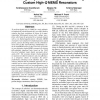Free Online Productivity Tools
i2Speak
i2Symbol
i2OCR
iTex2Img
iWeb2Print
iWeb2Shot
i2Type
iPdf2Split
iPdf2Merge
i2Bopomofo
i2Arabic
i2Style
i2Image
i2PDF
iLatex2Rtf
Sci2ools
CSREAESA
2004
2004
Driving Fully-Adiabatic Logic Circuits Using Custom High-Q MEMS Resonators
To perform digital logic in CMOS in a truly adiabatic (asymptotically thermodynamically reversible) fashion requires that logic transitions be driven by a quasitrapezoidal (flat-topped) power-clock voltage waveform, which must be generated by a resonant element with a very high Q (quality factor). Recently, MEMS resonators have attained very high frequencies and Q factors, and are becoming widely used in communications SoCs for RF signal filtering, amplification, etc. In the ADIAMEMS project at the University of Florida, we are designing custom MEMS resonators for driving fully-adiabatic pipelined logic based on the 2LAL (two-level adiabatic logic) family previously developed at UF. The resonator design is being optimized to maximize its effective Q factor and area efficiency, at a frequency chosen to maximize the powerperformance advantage of the adiabatic logic. Our analyses indicate that the adiabatic approach will eventually lead to orders-of-magnitude improvements in power-perfor...
| Added | 30 Oct 2010 |
| Updated | 30 Oct 2010 |
| Type | Conference |
| Year | 2004 |
| Where | CSREAESA |
| Authors | Venkiteswaran Anantharam, Maojiao He, Krishna Natarajan, Huikai Xie, Michael P. Frank |
Comments (0)

